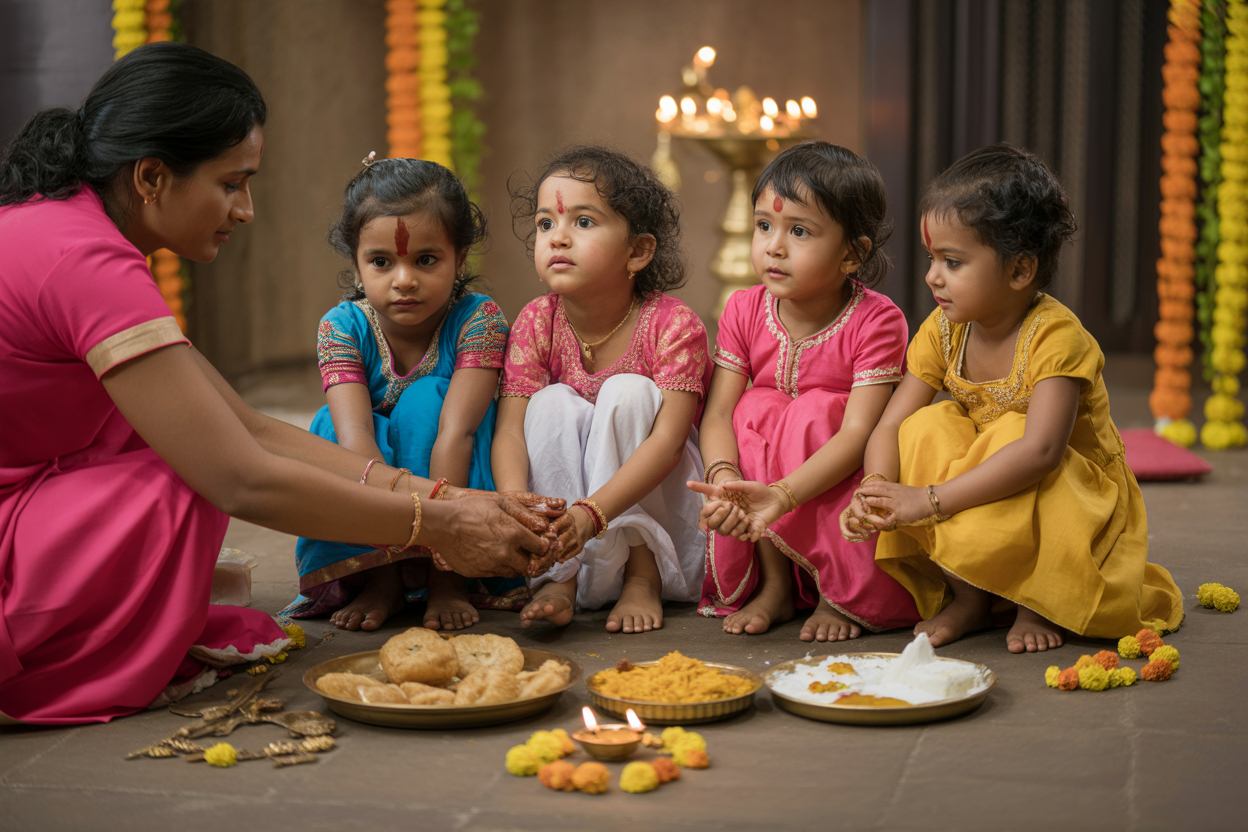Navratri, the nine-day festival dedicated to Goddess Durga, culminates with a very special ritual known as Kanjak Poojan or Kanya Pooja. Celebrated on Ashtami (eighth day) or Navami (ninth day) of Navratri, this ritual honors little girls as embodiments of the Goddess herself.
In Sanatan Dharma, every girl is considered a form of Devi Shakti—innocent, pure, and divine. Worshipping them during Navratri is believed to please Goddess Durga and invite her blessings of health, wealth, and protection.
Significance of Kanjak Poojan
- Manifestation of Devi in Kanyas
According to Devi Mahatmya, the Supreme Goddess manifested as nine different forms (Navdurga) to destroy demons. Worshipping nine little girls symbolizes invoking these nine forms of Durga. - Balance of Energy
A girl child represents Shakti Tattva (divine feminine energy). Inviting and honoring them balances positive vibrations and removes negativity. - Karmic Blessings
Feeding and gifting young girls is seen as an act of great punya (spiritual merit), believed to dissolve past karmic blocks and attract prosperity.
Kanjak Poojan and Astrology
- Moon Connection: Worshipping Kanyas brings emotional stability and peace of mind. Especially helpful during Moon afflictions like mental stress, wavering mind, or family issues.
- Venus Connection: Venus represents prosperity, harmony, and beauty. Pleasing Devi through Kanya Pooja strengthens Venus, ensuring marital bliss, creativity, and comforts.
- Navgraha Blessings: Since the girls represent Nav Durga, worshipping them harmonizes the influence of all nine planets. Thus, Kanjak Poojan is also considered a graha shanti ritual.
Rituals of Kanjak Poojan
- Inviting the Kanjaks: On Ashtami or Navami morning, 7, 9, or 11 young girls (below age 10) are invited home. Sometimes a young boy, called Langur, is also included, symbolizing Bhairav who protects the Goddess.
- Washing of Feet: The host washes the feet of the girls, symbolizing reverence to the living Goddess. A tilak is applied on their forehead, and red threads (mauli) are tied.
- Offering of Prasad: The traditional bhog includes puri, chana, and halwa—a sattvic meal representing nourishment, sweetness, and prosperity.
- Gifts and Dakshina: Each Kanya is offered new clothes, bangles, or small tokens along with money (dakshina), invoking abundance.
- Aarti & Mantra Chanting: Performing aarti of the little girls and chanting Durga Suktam or Navdurga mantras completes the ritual.
Spiritual and Practical Benefits
- Brings harmony and happiness in the home.
- Helps in resolving family disputes and emotional stress.
- Strengthens Venus and Moon, giving prosperity and peace.
- Invokes the blessings of Nav Durga for protection from misfortunes.
- Considered highly auspicious for those seeking marriage or childbirth.
Conclusion
Kanjak Poojan is a reminder of the divine feminine power that sustains the universe. It aligns us with the cosmic energy of Shakti, balances planetary influences, and invites abundance into our lives. This Navratri, when you welcome Kanjaks into your home, remember—you are not just feeding children, you are offering devotion directly to Maa Durga herself.


